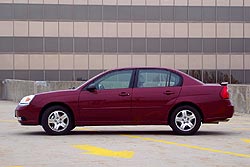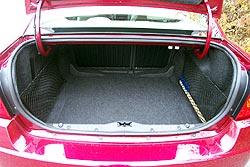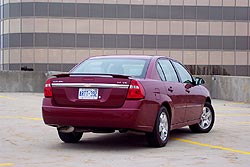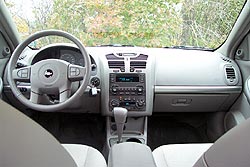 2006 Chevrolet Malibu Maxx SS; photo by Paul Williams. Click image to enlarge |
By Chris Chase
Discuss this story in the forum at CarTalkCanada
Find this vehicle in Autos’s Classified Ads
By Chris Chase
Mid-sized sedans don’t get much more mundane than the Chevrolet Malibu. Since 1997, this has been Chevy’s bread-and-butter family car, competing against sedans like the Ford Taurus, Chrysler Cirrus and Sebring and ubiquitous imports like the Honda Accord, Toyota Camry and Nissan Altima.
The Malibu was restyled in 2004 into a larger, more modern-looking car, but sadly gained little in distinctiveness, despite being based upon the same platform that underpins such GM-produced cars as the Saab 9-3 and the Europe-only Opel Vectra. Indeed, the new sedan was actually quite dowdy looking, especially compared to a concept sketch of the car released before the production model’s launch. That drawing portrayed the upcoming Malibu as – dare we say – kind of sexy.
  Chevrolet Malibu concept sketch (top) and the real thing, a 2004 Chevrolet Malibu, bottom; sketch courtesy of GM and bottom photo by Grant Yoxon. Click image to enlarge |
The new-for-2004 Malibu line-up was redeemed somewhat by the addition of a hatchback model called the Malibu Maxx. This version rode on a longer wheelbase than the sedan – 2,853 mm vs. 2,700 mm for the sedan – and had a rear seat that could be moved fore and aft.
For 2004, Malibus came in three flavours: a base model powered by a 2.2-litre four-cylinder engine (145 horsepower) and LS and LT versions, which got a 3.5-litre V6 engine (200 horsepower). In 2006, the LS became the base model and got the four-banger, as did the LT (the V6 was an option here), and LTZ models got the V6 as standard. A fourth model, wearing Chevy’s vaunted “SS” badge – denoting additional performance – arrived that year, sporting a 3.9-litre V6 good for 240 horses under the hood. All Malibus got a four-speed automatic transmission; on SS models, there was a manual shift function.
The choice between four or six cylinders can be a difficult one: should you go for the four-banger for lower fuel consumption or opt for the six for more useful power? In this case, six-cylinder power is our choice, as the fuel economy penalty over the smaller engine is negligible: 10 L/100 km (city) and 6.5 L/100 km (highway) for the four-cylinder and 10.5 L/100 km (city) and 6.8 L/100 km (highway) for the 3.5-litre V6, according to Natural Resources Canada. Only the big V6 in SS models threatens a bigger hit to the pocketbook, with ratings of 13.1 L/100 km (city) and 8.6 L/100 km (highway).
  2006 Chevrolet Malibu Maxx SS (top) and 2004 Malibu sedan (bottom); photos by Paul Williams and Grant Yoxon. Click image to enlarge |
General Motors has taken flak in the past for poor long-term durability in some of its V6 engines, notably the 3.1 and 3.4-litre motors used in the previous generation Malibu and other past GM cars like the Pontiac Grand Am. Word has it that this newer 3.5-litre engine features new intake manifold gaskets designed to correct the major fault with the old engines. In that case, faulty gaskets would allow radiator coolant to leak in to the engine block, contaminating the engine oil and sometimes causing catastrophic engine damage.
But there are other reliability items to look for in this generation Malibu. The electric power steering system is prone to failure (SS models use a more traditional hydraulic system which isn’t as troublesome; word has it that all 2007 Malibus will use this system), and there are complaints on the Malibu forums at Edmunds.com of steering racks that bind and make ugly noises.
There are also reports of brakes and suspension pieces that wear out prematurely. Symptoms of these issues include a pulsating brake pedal and creaking and grinding noises from the front end.
  2005 Chevrolet Malibu Maxx; photos by Haney Louka. Click image to enlarge |
Note that there are also a few electrical issues, the most common of which seems to be turn signal/hazard light relays that fail, resulting in signals that don’t work. In the Malibu Maxx with the optional double sunroof, some owners complain of a sunshade that refuses to stay closed.
Crash safety is good, with the Malibu earning five stars in all National Highway Traffic Safety Administration frontal crash tests. In side impacts, Malibus with side airbags got five stars for front passenger protection and four stars for rear passenger protection. Strangely, the side impact results are reversed in cars without side airbags. In 2004, side airbags were optional in LS models and standard in the LT (and not available at all in the four-cylinder base model); in 2005, they became available in the base model. For 2006, they were optional in the LS and standard in LT, LTZ and SS models. Traction control and ABS were available in all but the bottom end models, with upper-end cars getting these features as standard kit.
  2004 Chevrolet Malibu; photos by Grant Yoxon. Click image to enlarge |
Used Malibu prices range from $12,525 for a 2004 base model to $26,050 for a 2006 Malibu Maxx SS. The strongest value is probably a 2004 LT: the sedan is worth $15,950 and the Maxx carries a value of $16,500. These upper-end models have the most features and can probably be found for less than these Canadian Red Book values if you shop around. Go for a newer model and you’ll get more of the leftover warranty, too, though you’ll likely pay $19,000 to $22,000 for a loaded 2005 or 2006 model.
The basics seem to holding up reasonably well in these Malibus, though you’ll get more predictable dependability out of an Accord or Camry. A used Hyundai Sonata should cost about the same as a Malibu, and might be more reliable in the long term. The Malibu wouldn’t be our first choice, but the Maxx is a unique offering in the mid-size sedan segment. Our advice: if the Malibu fits your needs, get the best price you can to offset the possibility of future repairs, and get your prospective purchase checked out thoroughly by a mechanic you trust before signing anything.
Online resources
Related stories on Autos
Manufacturer’s Website
Transport Canada Recall Number: 2004140; Units affected: 5,334
2004: On certain vehicles, the Electronic Control Unit (ECU) may calculate a higher than actual vehicle speed because of an erratic rear-wheel speed sensor signal, and cause ABS activation where it is not needed or needed ABS activation to be extended during braking as the vehicle speed drops to about 5 km/h. A four-wheel ABS activation could occur for a maximum of 1.25 seconds on a level surface or for up to 2.5 seconds if the vehicle is on a grade, resulting in increased stopping distances of up to 3.4 m. Correction: Dealers will reprogram the ABS controller.
Transport Canada Recall Number: 2004071; Units affected: 4,761
2004: Certain vehicles that are not equipped with an Advanced Occupant Restraint System (AORS) have driver and passenger side sun visors with AORS labels. The AORS labels do not include statements and illustration required by CMVSS 208 for vehicles without AORS. Correction: Dealer will send replacement labels to owners with instructions on how to install them.
Transport Canada Recall Number: 2004139; Units affected: 8,320
2004: On certain vehicles, analysis of a side impact test indicated the outboard anchorage of the driver’s seat belt could disconnect because of contact between the seat trim and the anchorage connector when the seat was adjusted to its lowest position. If this occurred in a crash, the driver could receive greater injuries. Correction: Dealer will install a retainer between the latch spring and the latch spring guard on the anchorage – driver and passenger side.
Used vehicle prices vary depending on factors such as general condition, odometer reading, usage history and options fitted. Always have a used vehicle checked by an experienced auto technician before you buy.
For information on recalls, see Transport Canada’s web-site, www.tc.gc.ca, or the U.S. National Highway Transportation Administration (NHTSA)web-site, www.nhtsa.dot.gov.
For information on vehicle service bulletins issued by the manufacturer, visit www.nhtsa.dot.gov. For information on consumer complaints about specific models, see www.lemonaidcars.com.
Recalls










